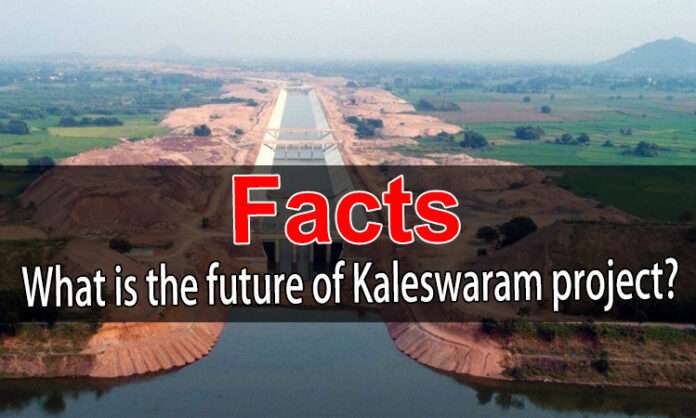The Kaleshwaram Lift Irrigation Project (KLIP) is the world’s largest multi-stage lift irrigation project that lifts a river to a height of over 600 meters from Medigadda the inception of the point of the KLIP at 100 meters. Medigadda Lakhsmi Barrage and its pump house at Kannepalli are among many such structures in the KLIP.
The length of the Lakshmi Barrage built by contracting firm L&T is 1.632 Km. It has 85 gates each with a size of 15 meters x 12 meters weighing over 215 tonnes each. The barrage has a storage capacity of 16.17 thousand million cubic feet (TMC) and can withstand a maximum flood discharge of 80,000 cumecs.
The inauguration of the Lakshmi Barrage took place in 2019, with the presence of the then Chief Ministers from Telangana, Andhra Pradesh, and Maharashtra. The Lakshmi barrage is strategically positioned just downstream from the confluence of the Pranahitha River. This juncture called ‘Sangamam” ensures a minimum assured flow of 300 (TMC) of water. The KLIP is designed to facilitate the lifting of 160 TMC of water annually, at the rate of 2 TMC per day with a provision to lift an additional TMC.
Parvathi, Saraswathi, and Lakshmi are the newly constructed barrages, each with a daily water lifting capacity of two TMC. Unfortunately, the Lakshmi Barrage is currently in a state of disrepair, and water lifting from this particular barrage is temporarily halted.
Addressing this issue requires the involvement of expert committees and the Central Water Commission (CWC), all of which fall within the purview of L&T, the project’s operator. Since L&T is responsible for operations and maintenance (O&M), they will be responsible for devising and implementing the necessary remedial measures. Meanwhile, the other pumphouses will continue their operations uninterrupted.
If the river Godavari does not experience floods and relies solely on Pranahitha water, the impact of damage to this barrage would be very significant. Conversely, when the past two years witnessed increased Godavari floods with no dependence on Pranahitha water, the extent of this loss would be comparatively minimal.
Highlights of Lakshmi Barrage and KLIP • The barrage will irrigate thousands of hectares of land and provide water to millions including the citizens of Hyderabad.
• The barrage is equipped with 85 hydromechanical radial gates fixed between the gigantic concrete piers
- The construction involved concrete used that was equivalent to building 7 Burj Khalifas, the steel used equivalent to building 15 Eiffel Towers, and earth excavated for 6 pyramids of Giza.
- The team set a world record by pouring 25,584 cum concrete in 72 hours.
- Pranahita is itself a convergence of numerous smaller tributaries including the Wardha, Painganga, and Wainganga rivers which combine to form the seventh-largest drainage basin on the subcontinent, with an estimated annual discharge of more than 6,427,900 acre-feet (7,930 cubic hectometres) or 280 TMC. It remains untapped as its course is principally through dense forests and other ecologically sensitive zones such as wildlife sanctuaries. • The KLIP is divided into 7 links and 28 packages spanning a distance of approximately 500 km (310 mi) through 13 districts and utilizing a canal network of more than 1,800 km (1,100 mi). • The project aims to produce a total of 240 TMC (195 from Medigadda Barrage, 20 from Sripada Yellampalli project and 25 from groundwater), of which 169 has been allocated for irrigation, 30 for Hyderabad municipal water, 16 for miscellaneous industrial uses and 10 for drinking water in nearby villages, with the remainder being estimated evaporation loss. • The project aims at increasing the total culturable command area (the sustainable area that can be irrigated after accounting for both upstream and downstream factors) by 1,825,000 acre⋅ft (2,251 hm3) across all 13 districts in addition to stabilizing the existing CCA. • The National Green Tribunal declared the Scheme was constructed without following the statuary provisions about environmental aspects.
- Four major pumping facilities manage the project’s outflow, the largest at Ramadugu (Medaram, Annaram and Sundilla being the others) is also likely to be the largest in Asia once consistent measurements are available, requiring seven 140 MWh (500 GJ) pumps designed and manufactured specifically for the project by the BHEL. • The Engineering giant Megha Engineering (MEIL) and Infrastructures Limited built 15 of 22 Pump houses and undertook a major part of the project.

